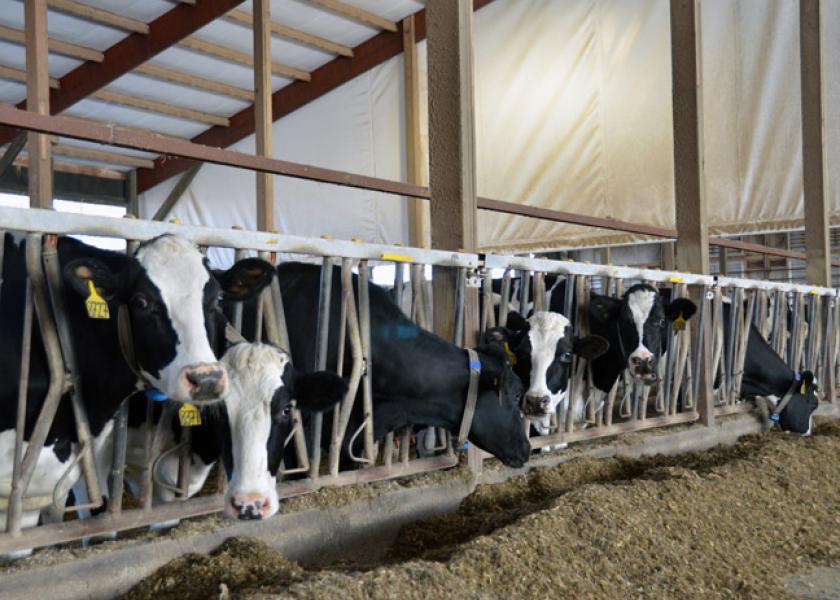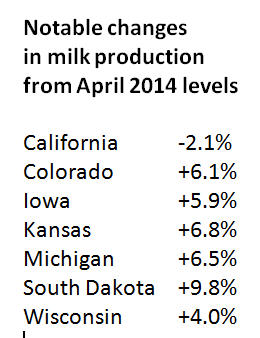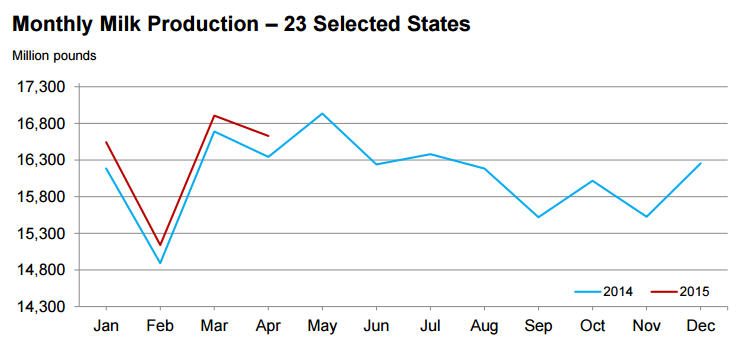USDA: Led by Midwest Growth, U.S. Milk Output Increases 1.7% in April

South Dakota, Kansas, Michigan and Colorado continue their rapid milk expansion, while California drops for the fifth straight month from year-earlier levels.
South Dakota, Kansas, Michigan and Colorado continued their rapid pace of milk expansion in April, leading all 23 major dairy states with the highest percentage increases over year-earlier levels, according to USDA’s monthly milk production report released today.
Meanwhile, California, the nation’s No. 1 milk producer, cut back its milk output for the fifth straight month compared to year-earlier levels, slipping 2.1% in April. New Mexico also reduced its production by 1.4%, and Oregon dropped its output by a slight 0.9%. They were the only three states where milk production dipped below April 2014 levels.
Overall, U.S. milk production rose 1.7% above year-earlier levels, although it declined from March 2015’s output. America’s dairies yielded 16.9 billion pounds last month, with the average per-cow production rising 16 lb. to 1,928 lb. in the 23 major dairy states.
“The milk growth reflects the strength in futures and the underlying cash price,” says Robin Schmahl, a commodity broker and dairy analyst with Ag Dairy LLC. “Producers aren’t cutting back or culling to slow production.”

In the Midwest, where much of the milk growth is occurring, Schmahl projects an overall price of $18.50-$19 per cwt. over the next 12 months, with Class III futures and the basis combined. In the Northeast and Southeast, prices will likely be higher.
“Most producers are going to cash-flow, and I believe milk production will stay in positive territory all year,” he says.
The number of milk cows in the 23 major states increased to 8.62 million head, 77,000 more than in April 2014 and 2,000 more than in March 2015.
South Dakota showed the largest percentage gain with 9.8% milk expansion from a year ago. “I expect that pace to continue,” says Roger Scheibe, executive director of the South Dakota Dairy Producers Association.
A concerted effort by state officials to boost the dairy industry is largely behind the growth. South Dakota has seen the arrival of new and upgraded dairy facilities, especially along the I-29 corridor in the eastern part of the state. Many South Dakota dairies house their herds in cross-ventilated barns, helping bolster cow comfort and maintain higher levels of production.
According to Scheibe, 70% of South Dakota’s milk comes from about 70 of the state’s 244 operations. Newer dairies are home to herds of 3,600-5,000 milking cows.
“Last week, another permit was approved for a 5,000-cow dairy,” Scheibe says. “Another 5,000-cow permit hearing will be held this week, and one other South Dakota operation is looking at another site to expand.
“Several dairies just finished adding more barns and pens, and more cows, in the last two to three months,” he adds. “Additional heifers and cows that would have been culled are now filling up those pens.”
More producers and exhibitors attended the Central Plains Dairy Expo, held in Sioux Falls, S.D., in March than ever before, says Scheibe. Among them were more than a dozen dairy producers from other states touring potential dairy sites and showing interest in relocating to South Dakota.








